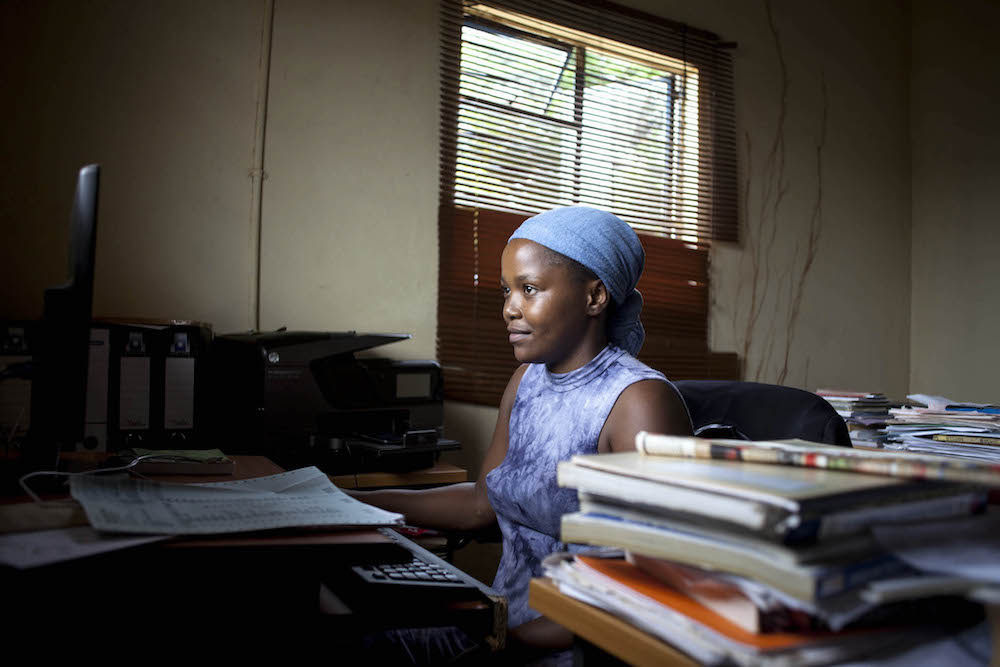Royal Swaziland Sugar Corporation
“This job is my way out,” says Nosisa Maseka. She does the books for the Sikuvile Farmers Association, based next to Swaziland’s northeastern border with South Africa. She loves numbers and can talk through the income and expenditure of the farm in the last year without looking at any notes.
But working in a two-room office (sandwiched between rows of green sugar cane) in the 40°C heat is just a stepping stone. “The temperature here is just too much. I don’t know how anyone survives it for so long.”
To escape, each weekend she gets on the bus and travels to her home, between Mbabane and Manzini. That round-trip costs R115 and takes two hours. It’s expensive but it means she can see her family, and attend classes, which are required as part of her long-distance course. By 2019, she’ll have an accounting degree and can then move to South Africa to get better work. “The work here is good in a way because it means I can afford my education. Then I can go and follow my dream.”

Nosisa Maseka. (Oupa Nkosi, M&G)
Other people in Sikuvile are able to do the same thing, thanks to the profits being made through growing and selling sugar cane. Half the sugar goes to Europe and 47% goes to neighbouring countries. Last year, even though there was a severe drought, each of the 44 households in the association earned about R50 000. That has meant school books and uniforms for children who previously did not get enough food, and one child from the group going to university to study agriculture.
This, says Mike Ogg – a consultant working on the Sikuvile projects and others like it in the region – is an example of how the image of sugar cane is changing. “In the past this was an extractive industry that damaged communities. Now it is definitely starting to change lives.”
Instead of only large sugar estates run by companies or rich individuals, there are now examples in the industry of new models that will benefit smallholder farmers and associations. Sikuvile is one of them.
Historically, sugar cane brought with it the worst in colonial and corporate excess.
The first crop came to Africa by way of Madagascar at the start of the 1800s. The French administration used slaves to compete with similar plantations in the Caribbean. The crop proved lucrative because of plentiful water resources and subtropical conditions.
Madagascan plantations proved so successful that the British administration in the then colony of Natal imported sugar cane in 1852. When a local labour pool proved impossible to muster, “Coolie Law No 14” was passed, allowing estate owners to bring in indentured labour from India. These labourers would work for five years on contract. If they then worked for another five, they would get a free ticket home or permanent residence.
That created a solid base for the industry to grow across the province. During apartheid South Africa, the twin arms of farmers and millers proved to be an important part of the country’s export industry. Water rights were channelled towards their development to the detriment of black residents.
The three big sugar-makers – Huletts, Tongaat and Transvaal Sugar – leveraged off this to expand into the region. Huletts established plantations in Swaziland in 1958, working alongside the Colonial Development Corporation.
But most of the growth has come after 1994, when South African companies were allowed to formally rejoin the regional economy.
Research into this, published last year in the Journal of Southern African Studies and titled The Political Economy of Sugar in Southern Africa, said harvests in the region have grown 80% in the last 20 years. It’s as a result of how manufacturers produce.
In Swaziland, all the open land and water resources had already been used up by the industry. The industry in Mozambique faced the same problem.
The solution has been in public-private partnerships, with the journal’s research saying this had allowed governments to find the kind of money needed to build infrastructure, such as irrigation.
With any sugar that is produced being given guaranteed markets by the mills, associations such as Sikuvile are able to get loans to start sowing cane and buy pumps to move water about their farms. Upriver of Sikuvile, is the Maguga Dam.
South Africa now produces 18-million tonnes, while Swaziland, Zimbabwe and Zambia each produce 5-million tonnes.
A far way off the 700-million tonnes of Brazil, this still means Sikuvile and other groups can move from depending on subsistence crops to sending their children to university.
For people such as aspirant accountant Maseka, it means a way to improve their lives.